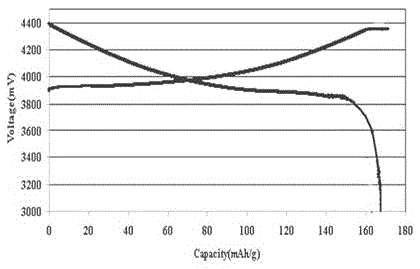Recycling method of positive electrode piece of lithium ion battery
A lithium-ion battery and positive electrode technology, which is applied in the field of lithium-ion battery positive electrode recycling, to achieve good structure and electrochemical characteristics, improve purity, and save costs
- Summary
- Abstract
- Description
- Claims
- Application Information
AI Technical Summary
Problems solved by technology
Method used
Image
Examples
Embodiment 1
[0024] Embodiment 1 (best embodiment)
[0025] Taking nickel-cobalt lithium manganese oxide (523 type) positive electrode sheet as an example, the recycling steps are as follows.
[0026] 1. Pole piece sorting and crushing: the pole piece is cut and broken, and the size of the pole piece is controlled at 1-10cm 2 .
[0027] 2. Organic solvent immersion: The broken pole pieces are soaked in organic solvent for 2 hours.
[0028] 3. Stirring treatment: First, carry out low-speed mechanical stirring on the soaked mixture for 1 hour, and the stirring speed is 15r / min. Ultrasonic stirring is then carried out, and the ultrasonic frequency range is 20KHz-35KHz, so that the two stirring methods are carried out at the same time, and the stirring time is 2h.
[0029] 4. Sieve filtration: the mixture of aluminum flakes and powder particles is separated by sieve filtration, and the sieve aperture is controlled at 0.4cm 2 , the aluminum sheet on the sieve is cleaned and filtered with ab...
Embodiment 2
[0039] Taking nickel-cobalt lithium manganese oxide (523 type) positive electrode sheet as an example, the recycling steps are as follows.
[0040] 1. Pole piece sorting and crushing: the pole piece is cut and broken, and the size of the pole piece is controlled at 1-10cm 2 .
[0041] 2. Organic solvent immersion: The broken pole pieces are soaked in organic solvent for 8 hours.
[0042] 3. Stirring treatment: First, carry out low-speed mechanical stirring on the soaked mixture for 1.5 hours, and the stirring speed is 50r / min. Ultrasonic stirring is then carried out, and the ultrasonic frequency range is 20KHz-35KHz, so that the two stirring methods are carried out at the same time, and the stirring time is 2h.
[0043] 4. Sieve filtration: the mixture of aluminum flakes and powder particles is separated by sieve filtration, and the sieve aperture is controlled at 0.6cm 2 , the aluminum sheet on the sieve is cleaned and filtered with absolute ethanol, and the number of times ...
Embodiment 3
[0051] Taking nickel-cobalt lithium manganese oxide (523 type) positive electrode sheet as an example, the recycling steps are as follows.
[0052] 1. Pole piece sorting and crushing: the pole piece is cut and broken, and the size of the pole piece is controlled at 1-10cm 2 .
[0053] 2. Organic solvent immersion: The broken pole pieces are soaked in organic solvent for 2 hours.
[0054] 3. Stirring treatment: First, carry out low-speed mechanical stirring on the mixture after soaking for 1 hour, and the stirring speed is 10r / min. Ultrasonic stirring is then carried out, and the ultrasonic frequency range is 20KHz-35KHz, so that the two stirring methods are carried out at the same time, and the stirring time is 1h.
[0055] 4. Sieve filtration: the mixture of aluminum flakes and powder particles is separated by sieve filtration, and the sieve aperture is controlled at 0.2cm 2 , the aluminum sheet on the sieve is cleaned and filtered with absolute ethanol, and the number of ...
PUM
 Login to View More
Login to View More Abstract
Description
Claims
Application Information
 Login to View More
Login to View More - R&D
- Intellectual Property
- Life Sciences
- Materials
- Tech Scout
- Unparalleled Data Quality
- Higher Quality Content
- 60% Fewer Hallucinations
Browse by: Latest US Patents, China's latest patents, Technical Efficacy Thesaurus, Application Domain, Technology Topic, Popular Technical Reports.
© 2025 PatSnap. All rights reserved.Legal|Privacy policy|Modern Slavery Act Transparency Statement|Sitemap|About US| Contact US: help@patsnap.com

